Written by Sig Silber
Updated at 5:57 pm EDT Monday June 1, 2020 – “…Severe weather and heavy rain to threaten the northern High Plains, Midwest, and Great Lakes ……Summer heat to stretch from coast-to-coast by mid-week……Elevated to Critical fire weather conditions across the Central Great Basin today…”
“
This article provides continuous updates for a variety of Weather and Weather-Related Threats as well as a general weather forecast. These are “Live” maps that continually update. Please pay attention to the Mesoscale Events maps — Mesoscale Events are potentially life-threatening situations.
Please share this article – Go to the very top of the page, right-hand side for social media buttons. Also, feel free to send this email to anyone you feel will benefit from it
Readers can scan through this article or jump to where they want to go via the links to the right. To get back to the Directory, hit the back arrow at the top of the URL bar on your screen. But in many cases, one of my Editors has graciously inserted a Return to Directory link to click so that is even easier. This is so high tech that I hardly believe it. |
|
CONUS Focal Points
Short Range Focal Points
Short Range Forecast Discussion NWS Weather Prediction Center College Park MD 356 PM EDT Mon Jun 01 2020 Valid 00Z Tue Jun 02 2020 – 00Z Thu Jun 04 2020
…Severe weather and heavy rain to threaten the northern High Plains, Midwest, and Great Lakes …
…Summer heat to stretch from coast-to-coast by mid-week…
…Elevated to Critical fire weather conditions across the Central Great Basin today…
A passing frontal system over the North Central U.S. is responsible for showers and thunderstorms marching across the western Great Lakes this afternoon. They will continue on their easterly track through the Great Lakes tonight and reaching portions of the northern Mid-Atlantic by Tuesday morning. In wake of this system, an upper-level disturbance passing through southern Canada will work in tandem with a stalled front over the Northern Plains and Upper Midwest to trigger additional showers and storms late Tuesday. With better jet dynamics aloft, severe weather is likely with damaging winds, large hail, and tornadoes all possible. Rainfall rates could also be quite high with localized flash flooding possible. Elsewhere, hit-or-miss showers and storms should be found across much of the South; from Texas to Florida. High pressure over the Southeast and Pacific Northwest through mid-week ensures an otherwise mostly dry pattern across the Lower 48.
As meteorological summer kicks off today, so too will an expansive dome of summer heat which quickly moves west to east over the next couple days. High temperatures will soar into the 90s across the Northern/Central High Plains and Midwest through Tuesday with triple digit heat entrenched across the Desert Southwest. Following a cool Monday, the West Coast should see temperatures return to summer-like levels. The East Coast manages one more day of seasonally cool temperatures Tuesday before considerably warmer and more humid conditions arrive on Wednesday. In addition, a critical risk for fire weather continues today in the central Great Basin. Elevated risks for fire weather extend east into western Colorado and on southward into the Lower Colorado River Valley.
The map below shows the current wildfire risk which becomes more significant as we move into Summer. When you click on this image it takes you to the SPC Fire Warning Page and you get a set of maps for Days 1, 2, 3 – 8, etc. You can then click on those for more detailed information. The map is a bit blurry as I tried to make it a bit larger than the map provided by NOAA but should be able to see where the current wildfire risks are. But if you click on this map, you will get to see three maps that show the risk for different time periods.
Thunderstorm Risk
This should play out something like shown in this 60 Hour Forecast Animation
Here is a national animation of weather fronts and precipitation forecasts with four 6-hour projections of the conditions that will apply covering the next 24 hours and a second day of two 12-hour projections the second of which is the forecast for 48 hours out and to the extent it applies for 12 hours, this animation is intended to provide coverage out to 60 hours. Beyond 60 hours, additional maps are available at links provided below. The explanation for the coding used in these maps, i.e. the full legend, can be found here although it includes some symbols that are no longer shown in the graphic because they are implemented by color-coding.

The two maps below break it down by day and may be easier to read.
Now, the Day One and Two CONUS Forecasts: These Maps Update Daily.
Day One CONUS Forecast | Day Two CONUS Forecast |
These graphics update and can be clicked on to enlarge. You can see where the weather will be | |
 | |
During the winter much of our weather originates in the Pacific. That is why we pay attention to the near-term history of storms arriving.
Temperature

Water Vapor.
This view of the past 24 hours provides a lot of insight as to what is happening. I changed the map to one that shows intensity. I think it may be relatively new. Not sure.
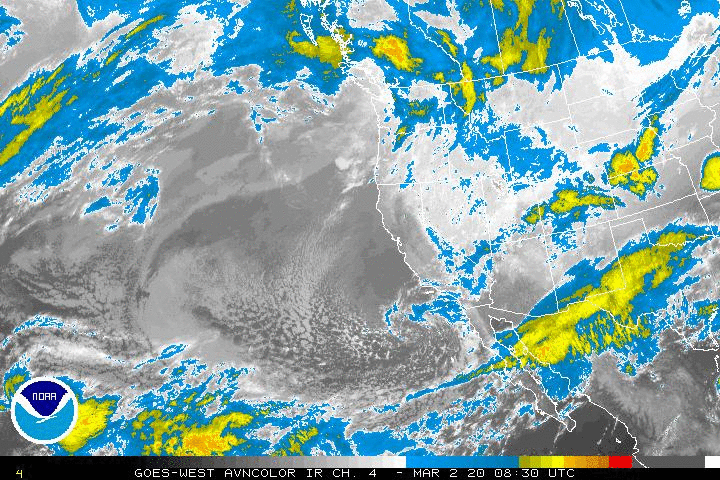
– Return to Directory
Day 3 – 7 Hazards
– Heavy rain across much of the Gulf Coast region from eastern Texas to all of Florida including portions of the Southeast, Fri-Mon, Jun 5-Jun 8.
– Severe weather across portions of the northern Plains, Thu, Jun 4.
– Flooding occurring or imminent across portions of the lower Mississippi Valley, the northern Plains, the northern Rockies, the Midwest, and the Carolinas.
– Flooding likely across portions of the Southeast and the Midwest.
– Much above normal temperatures across portions of the Intermountain West, central Great Basin, into the northern and central Rockies, and the northern and central High Plains, Thu-Fri, Jun 4-Jun 5.
– Much above normal temperatures over the central High Plains, Sat-Mon, Jun 6-Jun 8.
– Much above normal temperatures across portions of northwestern Alaska, Thu, Jun 4.
Detailed Summary:
The medium-range period (Thu Jun 4 – Mon Jun 8) will begin with much above normal temperatures over the interior western U.S. extending eastward into the northern and central High Plains under an upper ridge of high pressure. High temperatures over the central High Plains are forecast to reach the century mark Thursday and Friday. By the weekend, the much above normal temperatures should be confined to the northern and central High Plains as a large cool air mass works its way through the northwestern U.S. behind a cold front. Cool rain will tend to be focused along the Cascades together with the possibility of wet snow across the higher elevations of the Pacific Northwest and into the Intermountain region. Meanwhile, summer-like heat and humidity is expected to overspread much of the eastern U.S. Thursday through Saturday. By Sunday, a cold front is expected to bring down cooler and drier air from eastern Canada, ending the heat across much of the East Coast for early next week.
Perhaps the area that warrants growing concerns during the medium-range period is in the Gulf of Mexico, where the National Hurricane Center has been monitoring the potential for tropical cyclogenesis. Models have been indicating that a large area of disturbed weather associated with the remnants of tropical storm Amanda over Central America will gradually move northward toward the Gulf of Mexico. Although the exact track of this system is highly uncertain at this point, its relative large size means that many areas along the Gulf Coast will see an increasing threat of heavy rain toward the end of this week. This includes areas from eastern Texas through the central Gulf states to all of Florida including portions of the Southeast. The heavy rain may extend further inland west of the lower Mississippi Valley depending on the track and forward motion of the potential tropical system.
Elsewhere in the U.S., precipitation will generally be below heavy rain criteria through the medium-range period. However, bouts of showers and thunderstorms can be expected across the northern tier states due to occasional frontal passages. Some of the thunderstorms could be severe over portions of the northern Plains on Thursday.
Over Alaska, relatively quiet weather is in store through the medium-range period. Much warmer than normal temperatures across the northwestern part of the state will gradually moderate. However, ice jam flooding remains a concern over the North Slope as rivers have not yet broken up, while minor snowmelt flooding is a possibility in central and southern parts of the mainland. Farther south, some terrain-influenced/enhanced precipitation is expected to linger across southern Alaska, where wet snow is possible for the higher elevations. Precipitation amounts are not expected to be heavy.
(This is updated only during the week) Note the first list is weather highlights, this list is hazards. Not sure there is that much of a difference but they come from two different parts of NOAA. The Day 3 – 7 Hazards List does not update on weekends. But it is still useful as it remains valid for the period of time it covers. Of course, all forecasts are subject to change. Later we show a map of the hazards. Perhaps we should show them together.
Click here for the latest complete Day 3 -7 Hazards forecast which updates only on weekdays. It includes the full discussion which I do not update in this article but only present the highlights.
– Return to Directory
Ski Snow Reports
We will resume more detailed coverage when the summer is over.

We will update the above map weekly but more frequent updates can be obtained here.
There is not much snow left.
– Return to Directory
Tropical Events
This is now beyond the time of the year we pay special attention to Tropical Events other than the Western Pacific.
So I am replacing the large with three small maps but you can click on them to get larger versions. Even though they are small maps you should be able to tell if there is activity and If I see activity I will make the map where there is activity full size.
| the Central Pacific. | the Eastern Pacific | the Atlantic and the Gulf of Mexico |
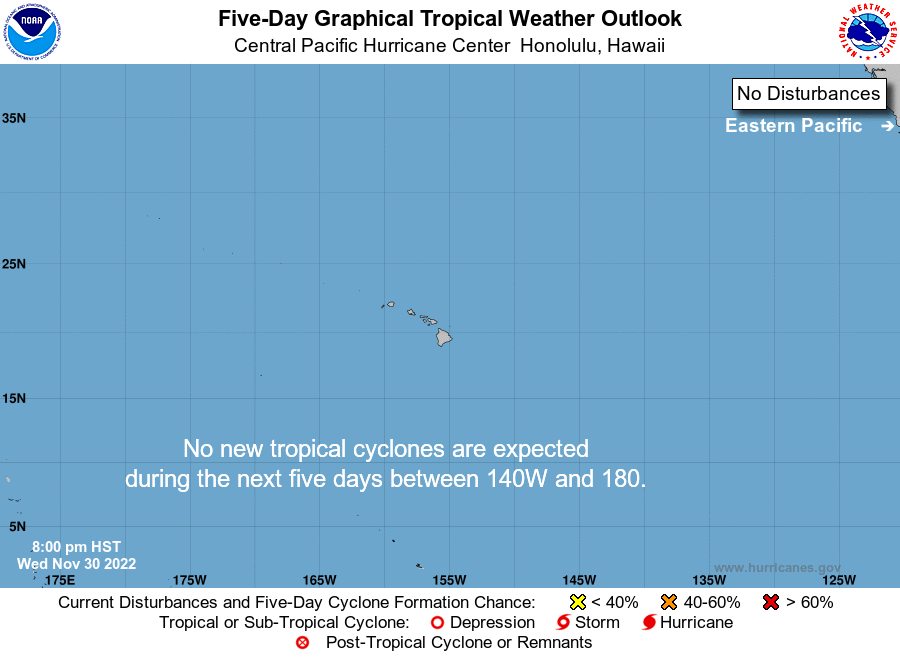 | 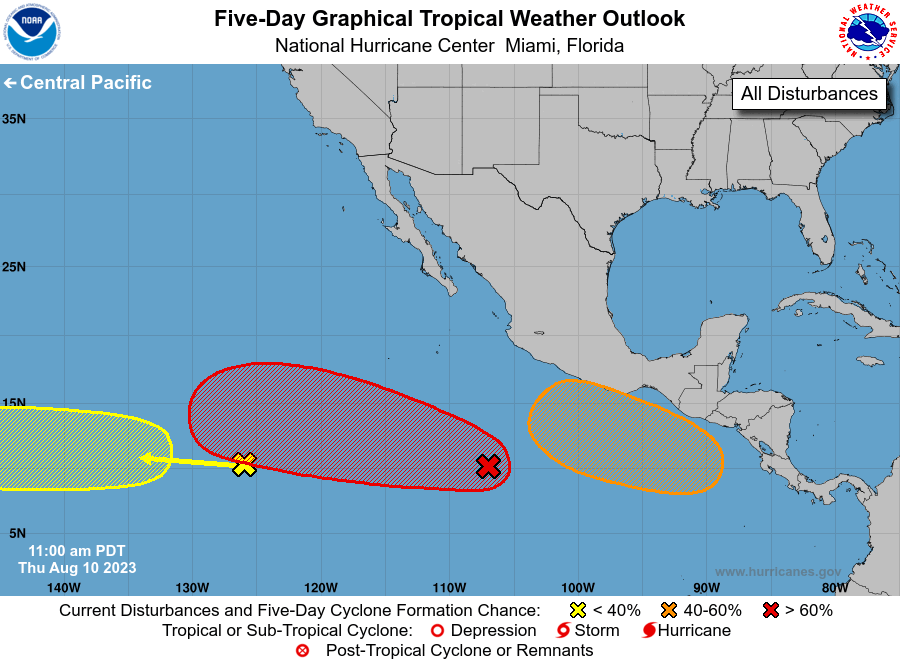 |  |
Updates on individual named storms can be obtained here.

 |
 |
And the Western Pacific


Week Tropical Forecast

– Return to Directory
Intermediate-Term Weather Forecast
And shifting to the Alaska and CONUS Intermediate-Term Weather Forecast showing from left to right, Days 1- 5, 6 – 10, 8 – 14 and Weeks 3 – 4 You can click on these maps to have them enlarge, there are larger versions in the Addendum (More Weather the link is shown at the end of this section, and there are larger versions of these maps in the Addendum. Also, the discussions that go with these forecast maps can be found here (first two weeks) and here (Weeks 3 and 4).
First Temperature
And then Precipitation
For those interested in more detail, there are additional weather maps and information in the MORE WEATHER Addendum. The link to the Addendum is here. |
– Return to Directory
Mesoscale Events
The following map shows where mesoscale events are occurring or forecast. If you do not see any areas highlight on this map than there are no mesoscale events taking place or forecast. A mesoscale event is a very serious situation for a very small area and detailed information is provided for these events when they occur or are forecast. If a mesoscale event is shown, click on the map and more detail on the event will be shown.
Two different parts of the NWS issue this map and they are not always in agreement although they are pretty close. They (Norman Oklahoma and College Park Maryland) issue the alerts when they realize the need, so it is best to look on both maps and click one or both if you see areas highlighted.
This next map showing where “Headlines” have been issued for convection (and an animation of the recent movement of storms) should update and you should be able to click on to get additional details but if it does not update when you click on it, click here.
There is a slight difference between convection and thunderstorms. The below map shows where “Headlines” have been issued for Thunderstorms. You should be able to click on the map to get additional details but if it does not update, you can click here.
The map below shows the current wildfire risk which becomes more significant as we move into Summer. When you click on this image it takes you to the SPC Fire Warning Page and you get a set of maps for Days 1, 2, 3 – 8, etc. You can then click on those for more detailed information. The map is a bit blurry as I tried to make it a bit larger than the map provided by NOAA but should be able to see where the current wildfire risks are. But if you click on this map, you will get to see three maps that show the risk for different time periods.
– Return to Directory
Now the Day 3 – 7 Hazards Outlook Maps

The orange and red outlined areas are what is most concerning of the forecasted Day 3 – 7 Hazards. This graphic does not update during the weekend. There is a discussion that goes with this graphic and you can access that discussion here.
The following is provided to help the reader relate the maps to how NWS will describe an area of the U.S.

– Return to Directory
Now to our More Detailed Weather Report
This graphic is about Atmospheric Rivers i.e. thick concentrated movements of water moisture. More explanation on Atmospheric Rivers can be found by clicking here or if you want more theoretical information by clicking here. The idea is that we have now concluded that moisture often moves via narrow but deep channels in the atmosphere (especially when the source of the moisture is over water) rather than being very spread out. This raises the potential for extreme precipitation events.
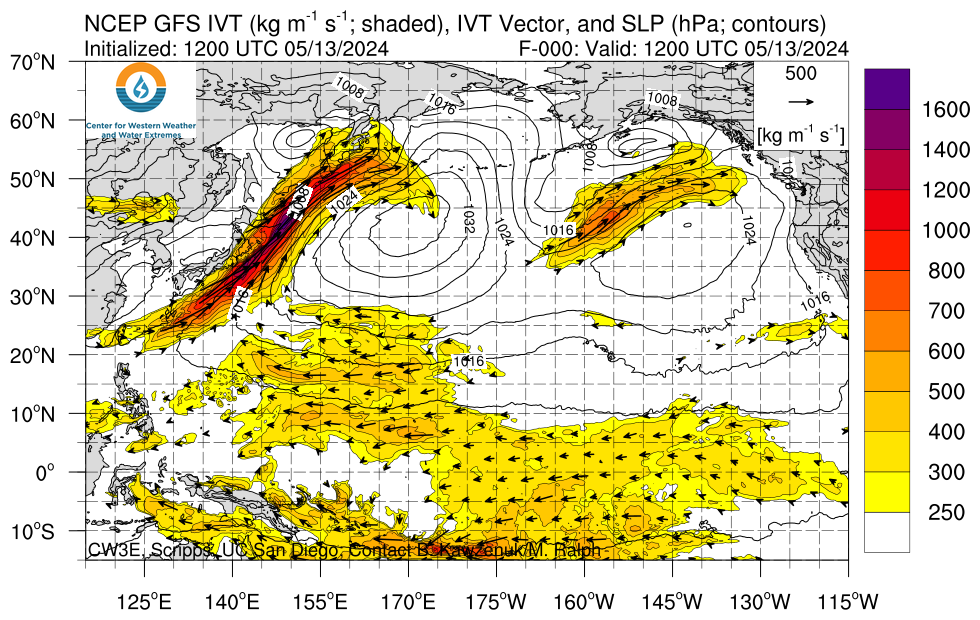
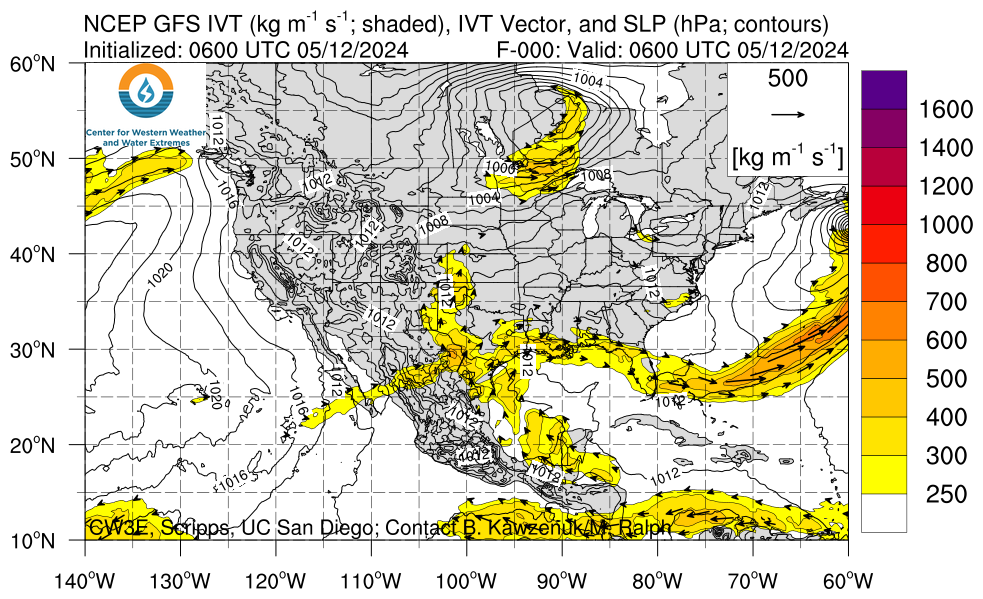
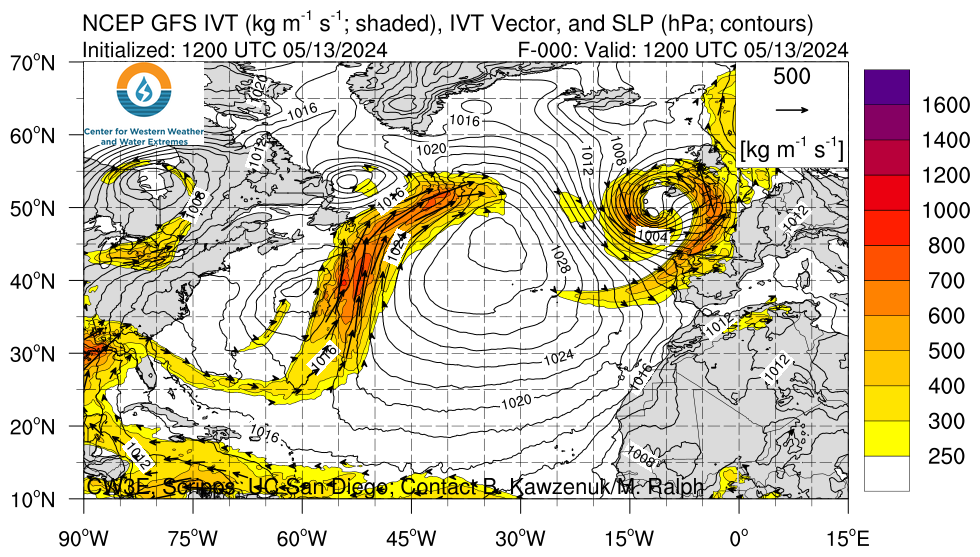
500 MB Mid-Atmosphere View
The map below is the mid-atmosphere 3-Day chart rather than the surface highs and lows and weather features. In some cases, it provides a clearer less confusing picture as it shows only the major pressure gradients. This graphic auto-updates so when you look at it you will see NOAA’s latest thinking. The speed at which these troughs and ridges travel across the nation will determine the timing of weather impacts. This graphic auto-updates I think every six hours and it changes a lot. Thinking about clockwise movements around High-Pressure Systems and counterclockwise movements around Low-Pressure Systems provides a lot of information.


| Day 3 Above, 6 Below | Day 4 Above,7 Below | Day 5 Above. |
 |  |  |
 |  |  |
Here are the precipitation forecasts. First the cumulative for Days 1 – 3

Then cumulative for Days 1 – 5
Then cumulative for Days 1 – 7

Now we look at the forecast for the Maximum Temperature three days out.
Looking ahead to next week.

– Return to Directory
Additional Tools to Obtain Watches and Warnings
| Current watches, warnings, and advisories issued by the agencies of the National Weather Service. Hazards should show up in the various maps but the below links will take you to all outstanding watches and warnings in each category which may include some categories not covered in the various maps or difficult to find. So if there is a category of interest, click on the appropriate link below. |
|
Below you will see a number of different maps that are updated in real-time, making this a “live” report. If a part of one or more of the maps shows an area that is highlighted, you can click on it and get the full current report. By having the reader click on these active situations rather than having GEI do so, you will not miss any events in which you might have an interest and which we had not noticed and the page will not get cluttered with warnings, etc that have since expired.
Our focus here is events that are likely to last in the range of six hours but there can be longer or shorter events that are addressed by the Storm Prediction Center which is the main source of the information in this article. Long-term major events like a Hurricane are more likely to be in a separate article. But that may not always be the case. Since in general, all the links on this page transfer you into the NOAA system, in order to get back into this article you need to either close the tab to which you were transferred or click back on the tab that has this article.
| Live Warning Maps which If Severe Weather is Shown can be Clicked on to get more detail about these events. If there is a current warning shown on the map, click on the map for additional information related to the event. | These maps are updated as risks are identified. |
| This is the current graphic showing any mesoscale discussions (MD’s) which are in effect over the contiguous United States. Please read the description of the purpose of our MD’s for further information. Details on all valid MD’s may be found on our Current Mesoscale Discussions page. |  |
| Convective Outlooks | |
|---|---|
| This is today’s forecast for organized severe thunderstorms over the contiguous United States. Please read the description of the risk categories for further information. You may find the latest Day 1 Outlook available as well as all Outlooks issued today online. | Today’s Outlook |
 | |
| This is tomorrow’s forecast for organized severe thunderstorms over the contiguous United States. Please read the description of the risk categories for further information. The latest Day 2 Outlook is available as well as all Outlooks that have been issued today. | Tomorrow’s Outlook |
 | |
| This is the day after tomorrow’s (day 3) forecast for organized severe thunderstorms over the contiguous United States. Please read the description of the risk categories for further information. The latest Day 3 Outlook is available as well as all Outlooks that have been issued today. | Day 3 Outlook |
 | |
| This is the day 4-8 forecast for organized severe thunderstorms over the contiguous United States. The latest Day 4-8 Outlook is available as well as all Outlooks that have been issued today. Note: A severe weather area depicted in the Day 4-8 period indicates a 30% or higher probability for severe thunderstorms (e.g. a 30% chance that a severe thunderstorm will occur within 25 miles of any point). | Day 4-8 Outlook |
 | |
| The Thunderstorm Outlooks depict the probability of thunderstorms across the contiguous United States in 4 or 8 hour time periods. The probabilistic forecast directly expresses the best estimate of a thunderstorm occurring within 12 miles of a point. The three probabilistic forecast thresholds are 10, 40, and 70 percent. | Thunderstorm Outlook |
 | |
| Fire Weather Outlooks | |
| This is today’s forecast for organized wildfires over the contiguous United States. Please read the description of the risk categories for further information about this product. | Today’s Outlook |
 | |
| This is tomorrow’s forecast for organized wildfires over the contiguous United States. Please read the description of the risk categories for further information about this product. | Tomorrow’s Outlook |
 | |
| This is day 3-8 forecast for organized wildfires over the contiguous United States. Please read the description of the risk categories for further information about this product. | Day 3-8 Outlook |
 | |























